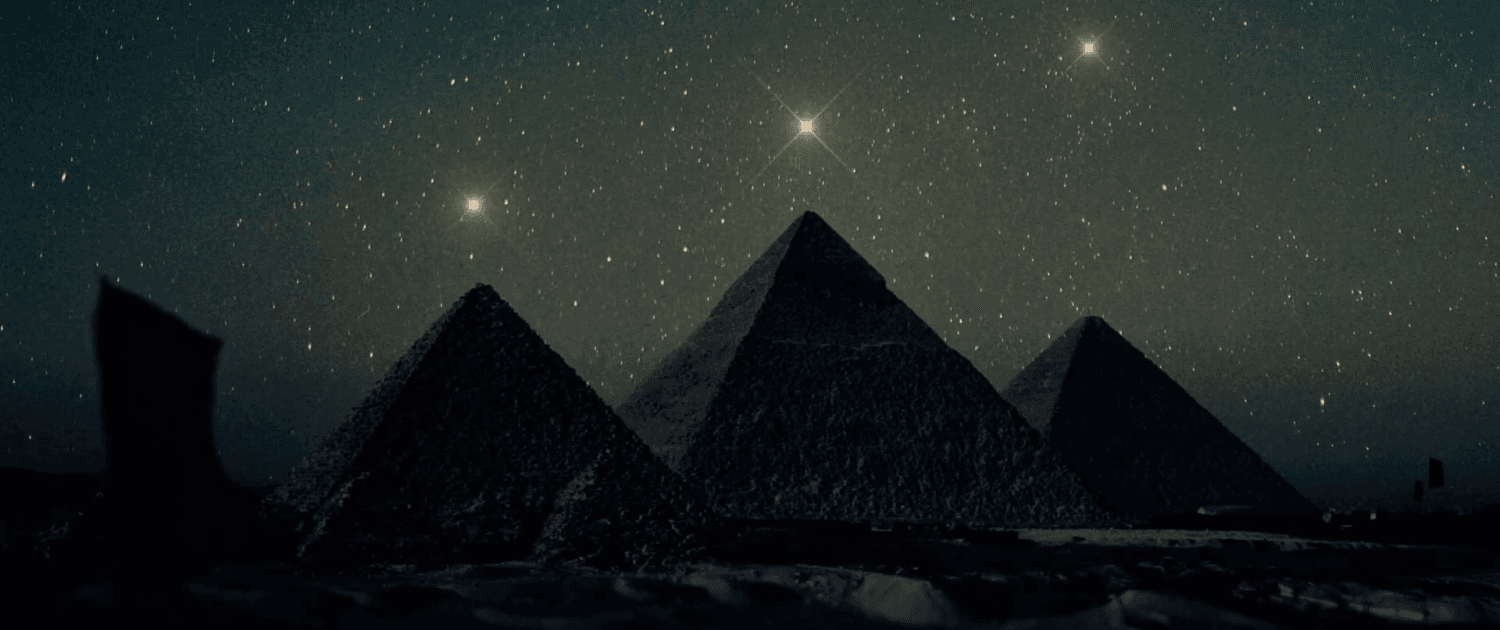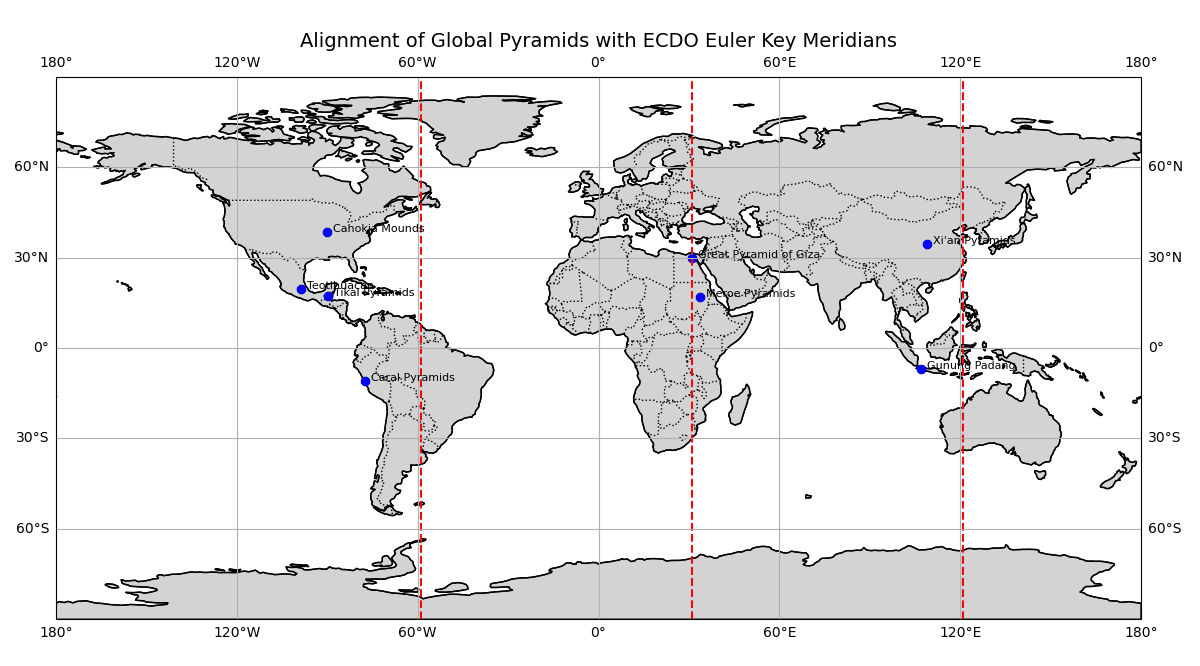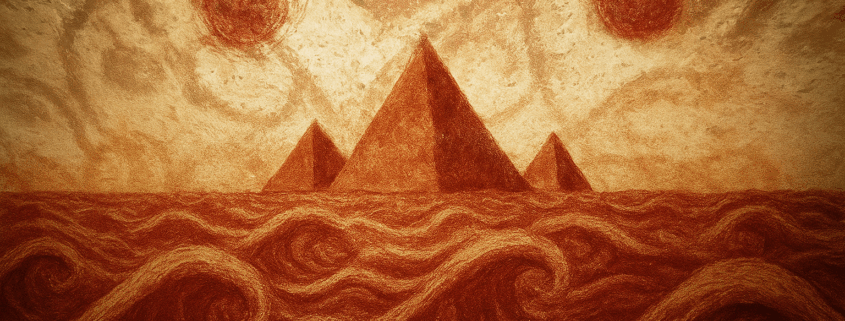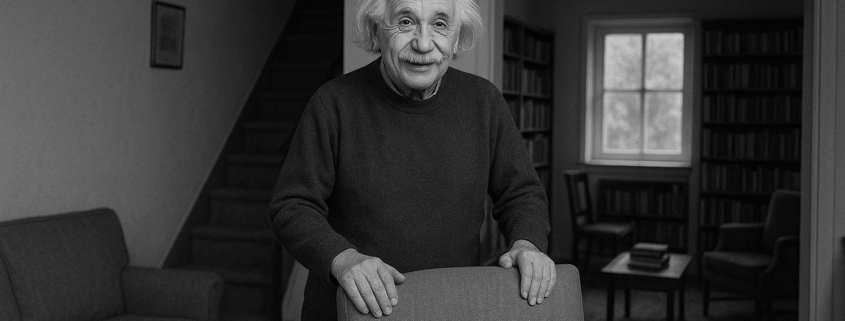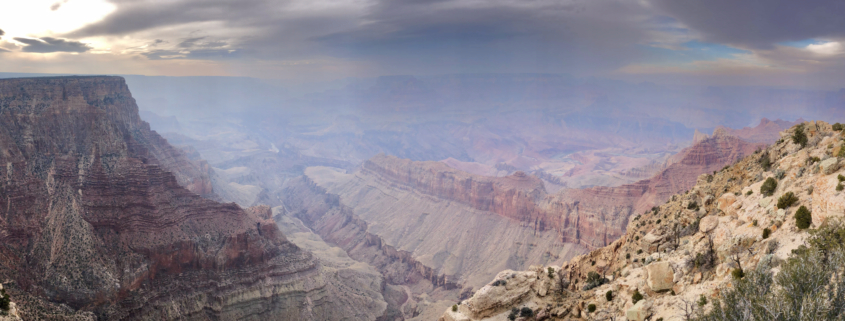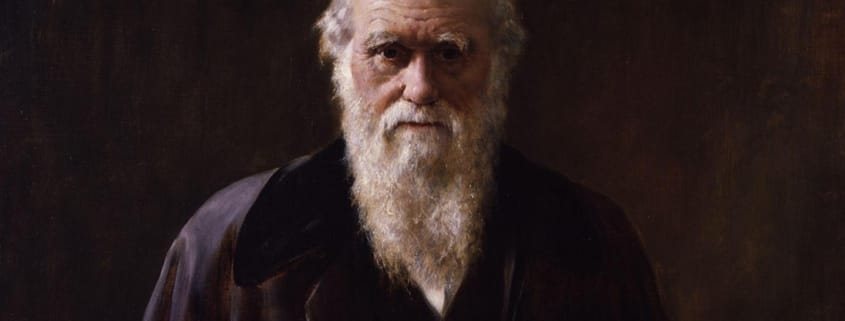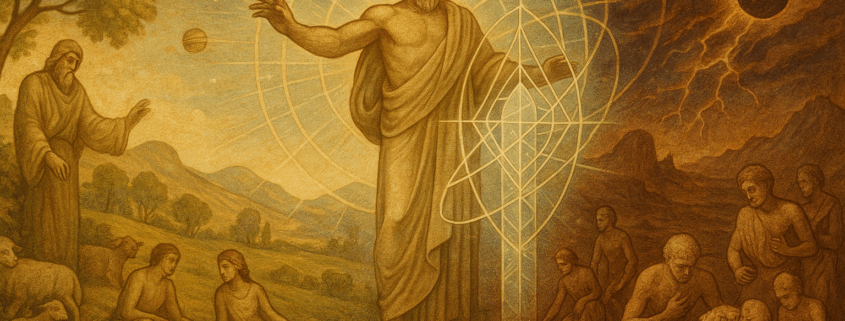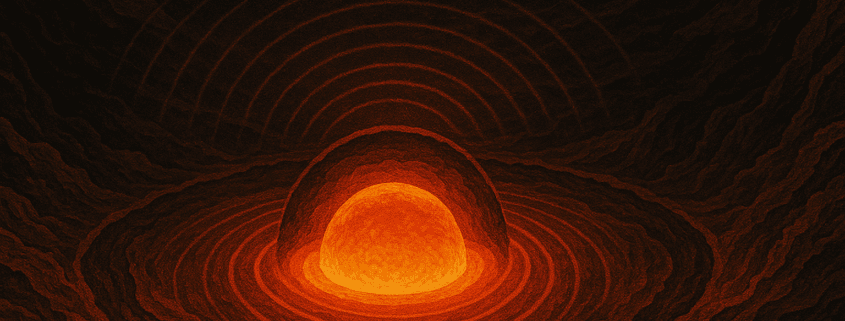In Egypt, we contend, lies the key and cradle of the whole mystery of the Primordial. We disagree with Le Plongeon that Yucatan was a more ancient seat of learning than Egypt, and we also maintain that the Mayas, as well as all the other ancient nations of the world, obtained their knowledge, either directly or indirectly, from the Egyptians. The Mayas, as their traditional history shows, certainly traded with the people of the Mediterranean, and there is reason to believe that they penetrated as far as the Himalayas. Probably these Mayas were the Egyptian Haui-Nibu (people beyond the seas), as it is stated that they were as civilized as the Egyptians about the time of the fifth dynasty, 3900 B.C. The texts show that these people were known long before this date. The translation is “People beyond the seas” or “the people from behind”—i.e., behind the setting sun. As the sun sets in the West and goes down into the sea, the Mayas would naturally be spoken of as people beyond the seas or “behind the setting sun.” Further proof may be found in the orientation of their temples and in their possession of the knowledge of building arches. That the Druids were evidently a more ancient people than the Mayas may be demonstrated by the fact that they had no knowledge of building arches, as well as other points we have brought before our readers.
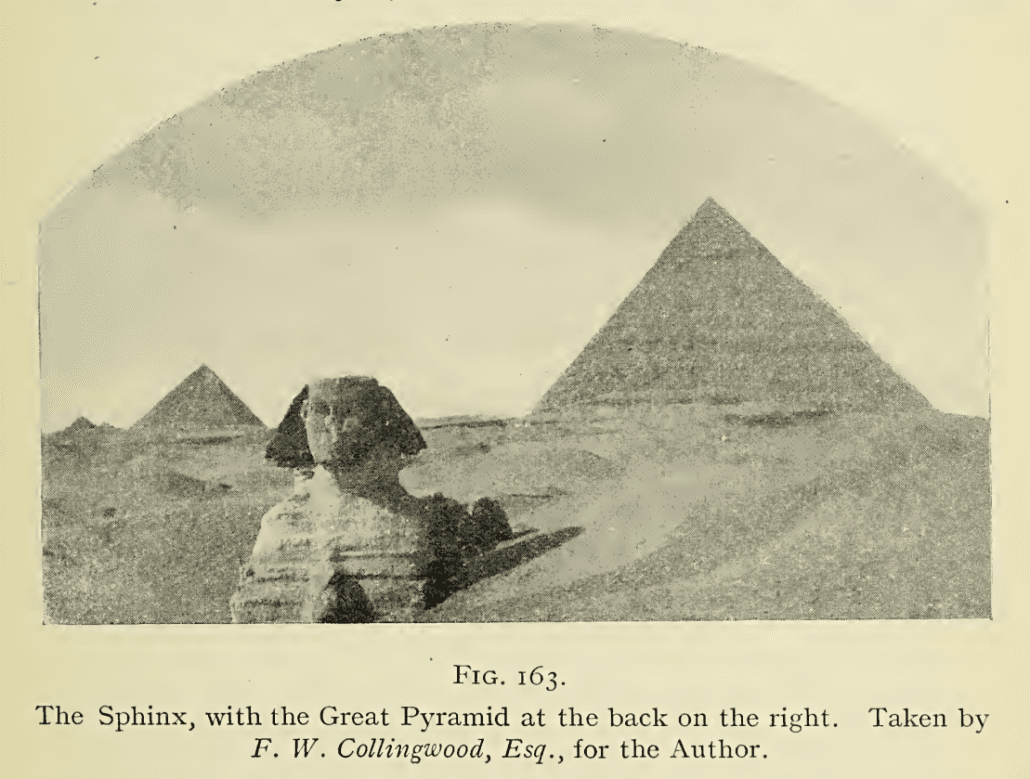
The Pyramids of Egypt are well known through the descriptions that have frequently been given of them by both ancient and modern writers. Some antiquarians think that they were originally intended as tombs for the ancient kings of Egypt. The Mahometans claim that they were built by the Preadamites. They mention particularly Gian-ben-Gian, the Universal Monarch of the World in the ages before Adam‘s creation. Ezekiel speaks of the sepulchres of the kings of Egypt, or rather he describes in a poetical manner the Deliverer of the Pharaohs going down to Hell—or into the deepest parts of the earth—with his army when put to death by the sword of the Chaldeans.
It was about the time of User-Ka-f that we find a number of shrines that united the chief characteristics of the low rectangular tomb—commonly known by its Arabic name of “Mastaba,” i.e., bench—and of the Pyramid were built. According to Prof. Sethe, this custom of building lasted only about 100 years—i.e., from the reign of User-Ka-f to that of Meu-Kau-Heru. This knowledge would be very important, if correct, as it would provide a more reliable date for when the Mayas took the Egyptian Solar Mythos into Yucatan, as we find this form of building there. Having seen them in Egypt, they would take the design back with them. We do not find these farther west than Yucatan and the lands of the Mayas. The remains of the Stellar Mythos are alone found beyond. We must not overlook the important point of the orientation of these pyramids and temples; the later ones in Yucatan are oriented E. by S., all the Druid remains that we have found are E. by S., and all the pyramids in Tankasi, Kurru, Zuma, Gebel Barkal, and Nuri, as well as the remains of the temples built by Nubian kings of the Sudan on both banks of the Nile near Meraiori, are all oriented E. by S., but the Great Pyramid of Ghizeh is oriented N.
The Mayas and the people of America also copied these, as can be seen from the remains of their ancient monuments today. The Pyramid of Teotihuacan, Mexico, according to Almarez, has, at a point 69 feet from its base, an opening with a gallery large enough to admit a man crawling on his hands and knees, which extends inward on an incline a distance of 25 feet and terminates in two square wells or chambers, each 5 feet square, with one 15 feet deep. Bancroft, however, states that the gallery is 157 feet long, increasing in height to 7 feet as it penetrates the pyramid, extending (apparently) down to the base and up to the summit, and that other cross galleries are blocked with stones, and the well is over 6 feet square (Tank of Flame). Nothing is mentioned about the form of entrance to this pyramid, but from the meager details, it is evidently a copy of the Great Pyramid of Egypt, with the details of their eschatology also written in stone here.
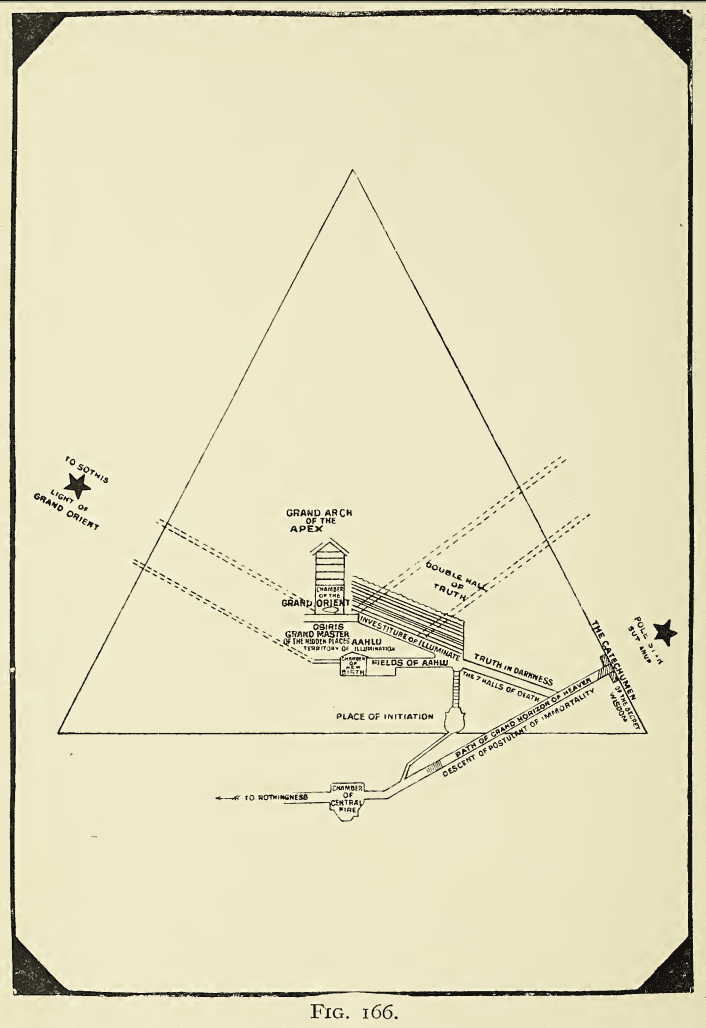 It would be interesting to know if the entrance was at the north and whether all other details of the internal construction were the same. Most probably, we shall in time find this to be so when it is thoroughly explored, and it may also add to our knowledge of the full internal construction of the Great Pyramid in Egypt, about which we are still in doubt, potentially enabling us to find yet another chamber. The one point, however, that impresses itself on the author is that the external measurements differ, so far as we can ascertain, but the site chosen is the same—i.e., the line through the center of the structure is in the Astronomical Meridian, and the buildings are oriented with slight variation. The construction in grades and steps is the same. This suggests that the Mexicans copied the Great Pyramid but built theirs during the Solar Mythos, whereas the Egyptian Pyramid was erected during the Stellar Mythos or when it was perfected. Since the Mayas obtained their doctrines from the Egyptians during the Solar Mythos, we would naturally find that the orientation was somewhat different. Of course, it is a question of orientation depending on whether it was built during the Stellar or Solar Mythos, which accounts for all the differences we find in the other pyramids in America as well, oriented either N or E. by S. There is also no doubt that they brought the Ritual with them, along with the copy of the Great Pyramid, but it was the Solar doctrines they brought directly—not Stellar, the knowledge of which they had obtained earlier from previous exoduses—and they associated their pyramids with the Solar alone later, whatever they did initially. We know there was intercommunication between the two peoples at the time of the 4th and 5th dynasties—4000 B.C.—and that the Solar doctrines were fully established 15,000 years ago in Egypt. If we calculate that these pyramids in Mexico are ten thousand years old, they must have been in communication and carried this over 5,000 years before the fifth dynasty, which is probably as close to the correct date as we can determine, and they would have had time to become as civilized as the Egyptians by the time of the fifth dynasty.
It would be interesting to know if the entrance was at the north and whether all other details of the internal construction were the same. Most probably, we shall in time find this to be so when it is thoroughly explored, and it may also add to our knowledge of the full internal construction of the Great Pyramid in Egypt, about which we are still in doubt, potentially enabling us to find yet another chamber. The one point, however, that impresses itself on the author is that the external measurements differ, so far as we can ascertain, but the site chosen is the same—i.e., the line through the center of the structure is in the Astronomical Meridian, and the buildings are oriented with slight variation. The construction in grades and steps is the same. This suggests that the Mexicans copied the Great Pyramid but built theirs during the Solar Mythos, whereas the Egyptian Pyramid was erected during the Stellar Mythos or when it was perfected. Since the Mayas obtained their doctrines from the Egyptians during the Solar Mythos, we would naturally find that the orientation was somewhat different. Of course, it is a question of orientation depending on whether it was built during the Stellar or Solar Mythos, which accounts for all the differences we find in the other pyramids in America as well, oriented either N or E. by S. There is also no doubt that they brought the Ritual with them, along with the copy of the Great Pyramid, but it was the Solar doctrines they brought directly—not Stellar, the knowledge of which they had obtained earlier from previous exoduses—and they associated their pyramids with the Solar alone later, whatever they did initially. We know there was intercommunication between the two peoples at the time of the 4th and 5th dynasties—4000 B.C.—and that the Solar doctrines were fully established 15,000 years ago in Egypt. If we calculate that these pyramids in Mexico are ten thousand years old, they must have been in communication and carried this over 5,000 years before the fifth dynasty, which is probably as close to the correct date as we can determine, and they would have had time to become as civilized as the Egyptians by the time of the fifth dynasty.
Their knowledge of the Stellar Mythos must have dated back many thousands of years before this and probably came from an exodus that left Egypt, traveled through Asia, and reached America via the Pacific coast. We are of the opinion that they obtained their Solar Mythos directly from the Egyptians through trading with them. This would explain why the Mayas had more of the Solar Mythos and had largely replaced much of the Stellar Mythos compared to tribes farther west and north, who retained more of the Stellar than the Solar. All the temples at Uxmal face east; those at Palenque, Copan, and Quirigua face north. All the temples in these latter cities have zootypes as symbols of the gods in sign language and must, therefore, date back to the Stellar Mythos, as the anthropomorphic representations came much later. As stated before, in Mexico, Central America, other parts of the world, and Egypt—from where these were derived—the people did not worship these great beasts; these were symbols of the Deity. It must be obvious that it was the Deity, not the symbols, they worshipped, just as we do not worship the Lamb in Christian doctrines, which is a symbolic representation of Christ. Similarly, in our lodges, we have symbols to represent the WM’s; these are not the WM but symbols by which they are known. In “The Knight of the Serpent,” we recognize the serpent only as a symbol of Tern, the god of the East and West, and Horus as the god of the North and South (Knights of the E. and W.).
Everyone knows—and some of our readers must have seen—that stupendous and most mysterious monument called the Great Pyramid of Ghizeh, not far from Cairo, which has been a subject of contention for years among scientific men and has no connection with any of the other pyramids built years later, except that of Teotihuacan.
The Great Pyramid, when understood, far surpasses and eclipses King Solomon’s Temple as a building—or any other in the world—and its wonderful secrets and hidden systems, embracing absolute mathematical precision and workmanship, can only be thoroughly understood through its relationship with the Ritual—the Pyramid Text—undoubtedly the oldest text in existence that we are acquainted with.
The base is a true square and perfectly oriented, set due N., E., S., W., parallel with the equatorial line, with absolutely no variation of points. Its base rests on a huge rock, perfectly and truly hewn and leveled to the earth’s curvature of 8 inches to the mile, the importance of which is evident—protecting it from convulsive damage over time. The height of the pyramid is 486.256 feet, and each side is 763.81 feet. The height thus corresponds to the radius of a circle whose circumference equals the four sides, a measurement exact when worked out in decimals, showing that these ancient architects could square the circle—a feat that has not been improved upon since. Its base side length is 365.242 sacred cubits, reflecting the number of days and the fractional part of a day in a year. The slope of the angles is parallel and commensurate with the earth’s pole and slope to the equinox, providing the angle from which the sun’s distance from the earth can be calculated at 91,840,000 miles. Additionally, it records twice in its construction the period called the precession of the equinoxes—25,827 inches, equal to 25,827 years—the one great year, or the time the sun takes to traverse through space around its center, as well as the recession of the 7 Pole Stars, or the 7 Glorious Ones. Through it, we may discover how the planets move in their different orbits and mathematically demonstrate their various revolutions. The distance from the pole equals the distance from the center.
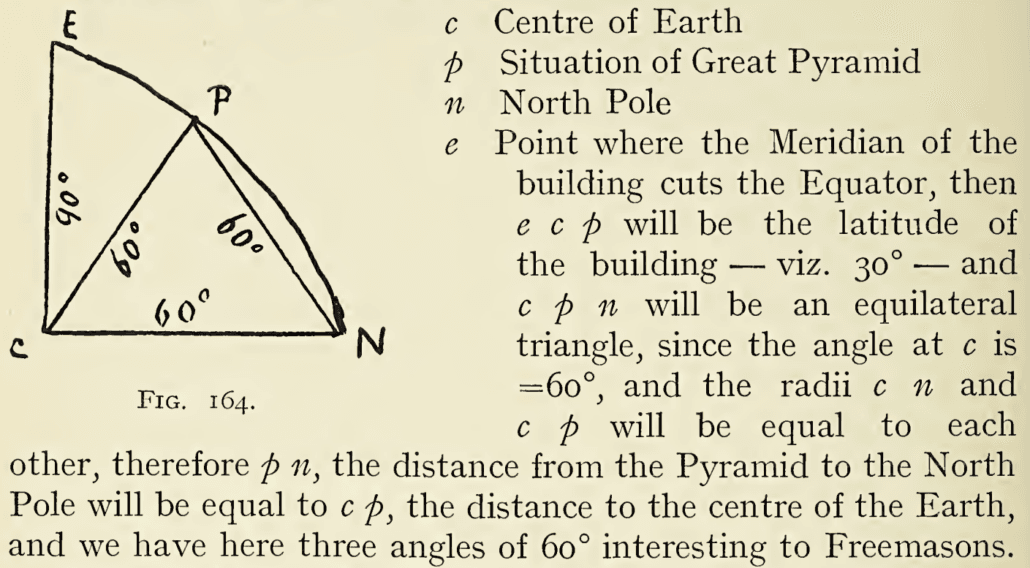
Here, in the Great Pyramid, is the one material center that provides the standard for practical things—weights, measures, etc.—and these were carried from land to land with the utmost care by the priests who left Egypt, no doubt for some future purpose under divine will, which is not yet apparent. The builders of the pyramid were masters of astronomical and geographical science, and it contains minute measurements of the earth and heavens, far exceeding the scientific knowledge of any person in our own time. This knowledge and its secrets were known to the High Priests, who carried out their understanding wherever they went. The Ark of the Covenant, built in the wilderness by Moses, Noah’s Ark, and King Solomon’s Temple all bear a true decimal proportion to the pyramid, as does the Ark or “Sarcophagus” in the King’s Chamber within the pyramid.
It may be that this pyramid was built by divine inspiration to stand for all time as a record, as suggested in Job 38, v. 5-7; Jeremiah 32, v. 18-20; and Isaiah 19, v. 19-20: “In that day there shall be an altar to the Lord in the midst of the land of Egypt and a pillar at the border thereof to the Lord, and it shall be for a sign and witness to the Lord of Hosts—until this day.” What should make this a sign and witness? That it is a copy of the Ritual written in stone, and only in conjunction with the Ritual can we properly understand it. And a pillar at the border thereof—what is that, and where is the answer? The answer is the Sphinx, a mighty pillar with all its secrets and hidden chambers still unread and buried in sand. Nevertheless, in time, this mighty pillar will be cleared, and its secrets, so long hidden, will be revealed to future generations to read and enlighten them about the mysteries of the past. The Ritual will help them decipher the meaning of these secret and hidden chambers and their contents written in stone.
The Sphinx at Ghizeh (in Egyptian, Hu), which Dr. Budge regards as the symbol of the Sun-god Ra, Temu, Khepera, Hern, Kuti, states, “It was made to keep away evil spirits from the tombs round about.” We cannot agree with Dr. Budge’s reason for its erection, since the names alone denote that it was erected as a monument to “The One Great God” and the “Seven Glorious Ones” and as a “pillar of the great wonder in Egypt,” as we read in the volume of the Sacred Law. Also, from the Ritual, we find that Ra, Temu, and Khepera are all one and the same—names of the great spirit under different dynasties in the Solar Mythos. “Hu” was also a name of Horus, as we find in the 80th chapter of the Ritual: “I have seized upon Hu from the place in which I found him,” and “I am the craftsman who lightens the darkness, and I come to dissipate the darkness that light should be.” For Heru and Kuti, we must go back to the Stellar Mythos. Heru represents Horus I, and Kuti denotes the Seven Glorious Ones, the Shining Ones, light, etc., and combined as Heru-Kuti, “the Light of the World.” The Ritual states of Heru-Kuti, “I am the Light of the World.”
The Sphinx was most certainly erected in connection with the Great Pyramid of Ghizeh, though after the latter. This is distinctly stated in the Ritual and the oldest Papyrus. It could not have been erected as the abode of the Sun-god, because it stands as a symbol of the passage of the sun from west to east—i.e., from sunset to sunrise. The ancient Egyptians took the sun as a representation of the powers of Ra, Temu, Khepera, etc.—seven names, in fact, of the Great Spirit. Kuti would then mean that these represented the Seven Glorious Ones in the Stellar Mythology, but Kuti also means light and was probably used as “the light of the Glorious Ones,” with Ra having taken the place of the Seven Glorious Ones as “The Light” in the Solar Mythos. To many, there may be difficulty in deciphering all these names under the consideration of the Solar Mythos, but to us, there is no difficulty, and the explanation is this: the Sphinx was erected after the Great Pyramid of Ghizeh as a monument to Heru-ur, or Horus I, and Heru-Kuti would mean a monument erected to Horus, “the Great Light of the World”—i.e., Horus. The God of the Pole Stars is the God of the Seven Glorious Ones, and when the Stellar Mythos merged into the Solar, Heru was brought forward as one god, but Ra took his place, and Temu, Khepera, etc., were other names for the same deity in different dynasties as supreme for the time. The sun, representing Ra, rose in the east and set in the west, diffusing the light of day from its rising to its setting, thus giving light to the world in the Solar Mythos.
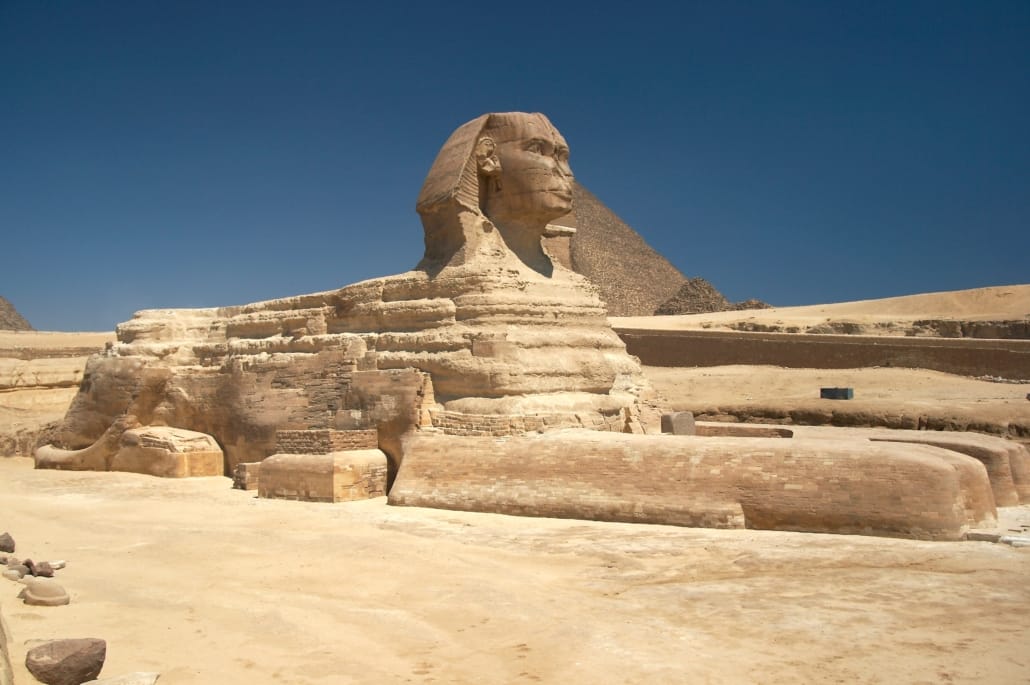 It is only by studying the Ritual of ancient Egypt in connection with these ancient monuments that we can arrive at anything like a true and clear conception of their ideas and beliefs. We cannot understand the volume of our Sacred Law if we simply take a literal translation as we have it, hence the various and differing opinions of many divines who honestly believe in the Bible and Christianity.
It is only by studying the Ritual of ancient Egypt in connection with these ancient monuments that we can arrive at anything like a true and clear conception of their ideas and beliefs. We cannot understand the volume of our Sacred Law if we simply take a literal translation as we have it, hence the various and differing opinions of many divines who honestly believe in the Bible and Christianity.
The one point on which Egyptologists might differ from us is the position of the Sphinx. The Sphinx faces the sun at rising (east), and in our opinion, this would indicate that it was built much later than the Great Pyramid, at a time when the Solar Mythos was taking the place of the Stellar—unless Mr. G. Massey is correct in his view. It would not alter the meaning or the reason but would only show how they brought forward and made use of the Stellar doctrines in their Solar Mythology. It was evidently a connecting link between the two, and when the future restores to us the hidden chambers buried here, light will be given to us. That these chambers exist, the Ritual proves to us, and there is no doubt in our minds that the ancient name of the Great Pyramid was “Khuti,” which denotes the seven Lights or Glorious Ones, and not merely light, as Mr. Marsh Adams has stated. It also signifies, as Heru-Kuti, the representation in stone of Horus I, the Light of the World, and all his doctrines—or the doctrines and divine message given to man at this early period to read and learn what he must do and what he had to pass through to triumph over darkness (ignorance), so that his soul and spirit, after this life, should find everlasting rest and happiness in the presence of the Divine God of Light and have full knowledge of all things.
Therefore, the ancient name of the Great Pyramid was “Khuti,” which denotes the seven Lights or Glorious Ones, and not merely light. This most mysterious monument stands today almost perfect and intact, while scarcely a vestige remains of all other structures that made up the marvels of the ancient world. The Great and Grand Pyramid of Ghizeh still stands, undestroyed and indestructible, ages after the lesser structures have passed away, as it stood ages before they ever came into existence. Certainly, more than fifty centuries—and how many more it is impossible to say for certain—have passed since the building first concealed from view those secret chambers and hidden mysteries, of which no other building on the globe contains the equal. What the concealed significance of that secret masonry may be, by whom and for what purpose the complex plan was designed, has perplexed many minds and created a large amount of discord.
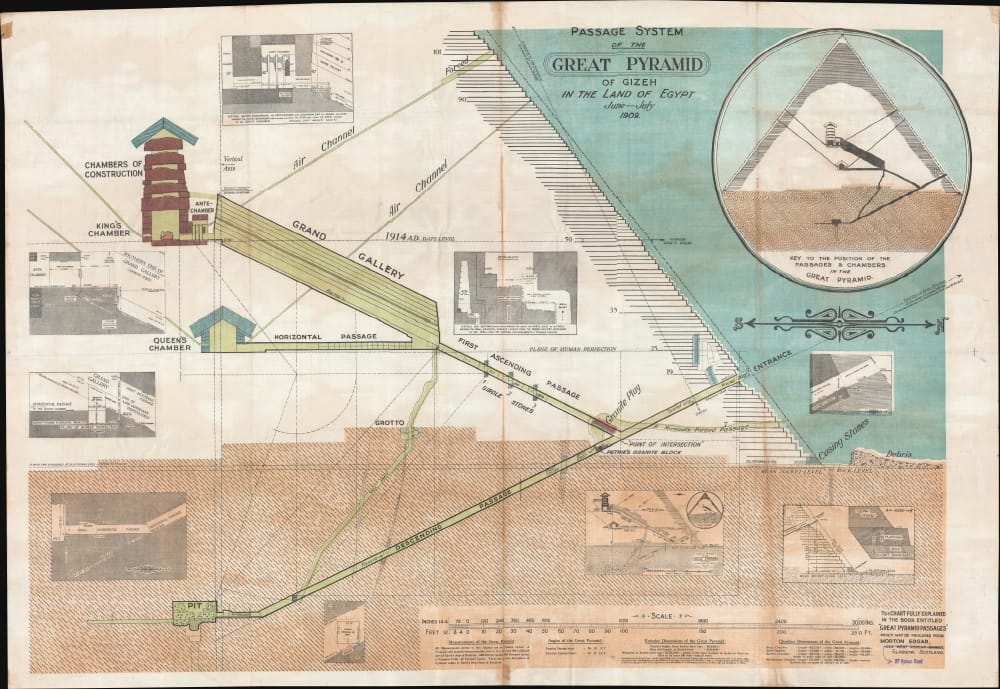 Maspero takes it for granted that the Great Pyramid of Ghizeh was built by Khufu; most other writers have followed his example. In his well-written book, “The Dawn of Civilisation,” he elaborates on what might have been and paints a pretty picture from his imagination—but are there facts to support his picture? If we turn to the papyri, we find that all the architectural plans of the building had been handed down to Num-Khufu (we do not like the word “Kheops” because it is Greek, and why use Greek in Egyptology when we have the Egyptian, which to our ears is quite as euphonious, if not more so? Num-Khufu is certainly a softer and pleasanter sound than Kheops). In all probability, the pyramid had been completed many thousands of years before Num-Khufu was born. The name Khufu or Kufu, King of the 4th dynasty, was found cut on a stone dating back to the king of the 1st dynasty at Bubastis. There is evidence that his grandfather had obtained these plans from his ancestors, and they were handed down simply to provide the “key to the building.” The fact that the name was found written on the side of a stone built into the north wall does not necessarily identify the builder, for we find in the Papyrus of Nu that it was part of the eschatological ceremony to engrave four different names on four stones, which were to be built into the north, south, east, and west walls. The names on these stones were different names of the guardians who protected the north, south, east, and west and might have been changed with each “Grand Master” or dynasty. This has a very significant meaning to Freemasons, who will be interested in understanding it if it were so, and we find that the temples in Central America had the same, either written or depicted in sculptured figures. These four names, as we have stated before, the guardians of N., E., S., and W., are the four children of Horus.
Maspero takes it for granted that the Great Pyramid of Ghizeh was built by Khufu; most other writers have followed his example. In his well-written book, “The Dawn of Civilisation,” he elaborates on what might have been and paints a pretty picture from his imagination—but are there facts to support his picture? If we turn to the papyri, we find that all the architectural plans of the building had been handed down to Num-Khufu (we do not like the word “Kheops” because it is Greek, and why use Greek in Egyptology when we have the Egyptian, which to our ears is quite as euphonious, if not more so? Num-Khufu is certainly a softer and pleasanter sound than Kheops). In all probability, the pyramid had been completed many thousands of years before Num-Khufu was born. The name Khufu or Kufu, King of the 4th dynasty, was found cut on a stone dating back to the king of the 1st dynasty at Bubastis. There is evidence that his grandfather had obtained these plans from his ancestors, and they were handed down simply to provide the “key to the building.” The fact that the name was found written on the side of a stone built into the north wall does not necessarily identify the builder, for we find in the Papyrus of Nu that it was part of the eschatological ceremony to engrave four different names on four stones, which were to be built into the north, south, east, and west walls. The names on these stones were different names of the guardians who protected the north, south, east, and west and might have been changed with each “Grand Master” or dynasty. This has a very significant meaning to Freemasons, who will be interested in understanding it if it were so, and we find that the temples in Central America had the same, either written or depicted in sculptured figures. These four names, as we have stated before, the guardians of N., E., S., and W., are the four children of Horus.
The orientation of the Great Pyramid was undoubtedly determined by stellar observation (a very important fact to note) at the time when the Stellar Mythology had been perfected.
Proctor states:
It would seem that the builders of the pyramid were anxious to place it in latitude 30° as precisely as their means of observation permitted. Let us consider what result they achieved and the evidence thus afforded respecting their skill and scientific attainments. In our own time, of course, the astronomer has no difficulty in determining with great exactness the position of any given latitude parallel. But at the time when the Great Pyramid was built, it must have been a matter of very serious difficulty to determine the position of any required latitude parallel with a great degree of exactitude. The most obvious way of dealing with the difficulty would have been by observing the length of shadows thrown by upright posts at noon in spring and autumn. In latitude 30° north at noon in spring (or, to speak precisely, on the day of the Vernal Equinox), the sun is just twice as far from the horizon as it is from the point vertically overhead; and if a pointed post were set exactly upright at true noon (supposed to occur at the moment of the Vernal or Autumnal Equinox), the shadow of the post would be exactly half as long as a line drawn from the pole to the end of the shadow. But observations based on this principle would have presented many difficulties to the architects of the pyramid. The sun, not being a point of light but a globe, means the shadow of a pointed rod does not end in a well-defined point. The moment of true noon, which is not the same as the ordinary or civil noon, never agrees exactly with the time of the Vernal or Autumnal Equinox and may be removed from it by any interval of time not exceeding twelve hours. And there are many other circumstances that would lead astronomers—like those who doubtless presided over the scientific preparations for building the Great Pyramid—to prefer a means of determining the latitude depending on another principle. The heavens would afford practically unchanging indications for their purpose. The stars, being all carried around the pole of the heavens as if they were fixed points in the interior of a hollow revolving sphere, make it possible to determine the position of the pole of the star sphere, even though no bright, conspicuous star actually occupies that point. Any bright star close to the pole is seen to revolve in a very small circle, whose center is the pole itself. Such a star is our present so-called Pole Star; and though in the days when the Great Pyramid was built, that star was not near the pole, another—and probably brighter—star lay near enough to the pole to serve as a Pole Star and to indicate by its circling motion the position of the actual pole in the heavens.
This star, called Thuban—from the Arabic al-Thuban, the Dragon—is now very bright, being rated barely above the fourth magnitude, but it was formerly the brightest star of the constellation, as its name indicates. Bayer also assigned to it the first letter of the Greek alphabet, though this is not absolutely decisive evidence that, as late as his day, it retained its superiority over the second-magnitude stars to which Bayer assigned the second and third Greek letters.
In the year 2790 B.C. or thereabouts, the star was at its nearest to the true north pole of the heavens, the diameter of the little circle in which it then moved being considerably less than one-fourth the apparent diameter of the moon. At that time, the star must have seemed, to all ordinary observation, an absolutely fixed center around which all the other stars revolved. At the time when the pyramid was built, this star was about sixty times farther removed from the true pole, revolving in a circle whose apparent diameter was about seven times as great as the moon’s; yet it would still be regarded as a very useful Pole Star, especially as there are very few conspicuous stars in the neighborhood. This was, at that time and for many subsequent centuries, the leading star of the great constellation called ‘The Dragon.’
The pole of the heavens, as we know, varies in position according to the latitude of the observer. At the North Pole, it is exactly overhead. At the equator, the poles of the heavens are both on the horizon; and as the observer travels from the equator toward the North or South Pole of the earth, the corresponding pole of the heavens rises higher and higher above the horizon. In latitude 30°, or one-third of the distance from the equator to the pole, the pole of the heavens is raised one-third of the way from the horizon to the point vertically overhead; and when this is the case, the observer knows they are in latitude 30°. The builders of the Great Pyramid, with the almost constantly clear skies of Egypt, may reasonably be supposed to have adopted this means of determining the true position of that 30th parallel on which they appear to have designed to place the great building they were about to erect.
It so happens that we have the means of forming an opinion on the question of whether they used one method or the other—whether they employed the sun or the stars to guide them to the geographical position they required. In fact, were it not for this circumstance, we would not have thought it worthwhile to discuss the qualities of either method. It will presently be seen that the discussion bears importantly on the opinion we form of the skill and attainments of the pyramid architects. Every celestial object is apparently raised somewhat above its true position by the refractive power of our atmosphere, being most raised when nearest the horizon and least when nearest the point vertically overhead. This effect is so marked on bodies close to the horizon that if the astronomers of the pyramid times had observed the sun, moon, and stars attentively when so placed, they could not have failed to discover the peculiarity. Probably, however, though they noted the time of rising and setting of the celestial bodies, they only made instrumental observations on them when these bodies were high in the heavens. Thus, they remained ignorant of the refractive powers of the air. Even that skillful astronomer, Hipparchus—who may justly be called the father of observational astronomy—overlooked this peculiarity, which Ptolemy seems to have been the first to recognize. Now, if they had determined the position of the 30th parallel of latitude by observation of the noonday sun (in spring or autumn), then, owing to refraction, they would have judged the sun to be higher than it really was; it follows that they would have supposed the latitude of any station from which they observed to be lower than it actually was, for the lower the latitude, the higher the noonday sun at any given season. Thus, when really in latitude 30°, they would have supposed themselves in a latitude lower than 30° and would have traveled a little farther north to find what they considered the proper place for erecting the Great Pyramid. On the other hand, if they determined the place from observations of the movements of the stars near the pole of the heavens, they would make an error of a precisely opposite nature; for the higher the latitude, the higher the pole of the heavens, and refraction, which apparently raises the pole of the heavens, gives a station the appearance of being in a higher latitude than it really is, so that the observer would consider they were in latitude 30° north when, in reality, they were somewhat south of that latitude. We have only then to inquire whether the Great Pyramid was set north or south of latitude 30° to ascertain whether the pyramid architects observed the noonday sun or circumpolar stars to determine their latitude—always assuming, as we reasonably may, that those architects intended to set the pyramid in that particular latitude, were able to make very accurate observations of the apparent positions of the celestial bodies, but were not acquainted with the refractive effects of the atmosphere. The answer comes in no uncertain terms. The center of the Great Pyramid’s base lies about one mile and a third south of the 30th parallel of latitude, and from this position, the pole of the heavens, as raised by refraction, would appear to be very near indeed to the required position. In fact, if the pyramid had been set about half a mile farther south, the pole would have seemed just right.
Of course, such an explanation as we have suggested appears altogether heretical to the Pyramidalists. According to them, the pyramid architects knew perfectly well where the true 30th parallel lay and also understood all that modern science has discovered about refraction; but they set the pyramid south of the true parallel and north of the position where refraction would just have made the apparent elevation of the pole correct, simply so that the pyramid might correspond as nearly as possible to each of two conditions, neither of which could be fulfilled simultaneously. The pyramid would indeed, they say, have been set even more closely midway between the true and apparent parallels of 30° north, but the Jeeseh hill on which it is set does not afford a rock foundation any farther north. “So very close,” says Professor Smyth, “was the Great Pyramid placed to the northern brink of its hill that the edges of the cliff might have broken off under the terrible pressure, had not the builders banked up most firmly the immense mounds of rubbish that came from their work, which Strabo looked for so particularly 1,800 years ago but could not find. Here they were, however, and still are, utilized in enabling the Great Pyramid to stand on the very utmost verge of its commanding hill, within the limits of the two required latitudes, as well as over the center of the land’s physical and radial formation, and at the same time on the sure and proverbially wise foundation of rock.” (Peter-Cephas—a Stone.) “Thou art Peter, and upon this rock I will build my Church” (St. Matt. 16:18).
The next circumstance to be noted in the position of the Great Pyramid (as with all pyramids) is that the sides are carefully oriented. This, like the approximation to a particular latitude, must be regarded as an astronomical rather than a geographical relation. The accuracy with which the orientation has been effected will demonstrate how far the builders had mastered the methods of astronomical observation by which orientation was to be secured. The problem was not as simple as might be supposed by those unacquainted with how the cardinal points are correctly determined. By solar observations—or rather by observing shadows cast by vertical shafts before and after noon—the direction of the meridian, or north-south line, can theoretically be ascertained, but probably in this case, as in determining the latitude, the builders took the stars as their guide. The pole of the heavens would mark the true north, and equally, the Pole Star, when below or above the pole, would indicate the true north—but most conveniently when below the pole. Nor is it difficult to see how the builders would make use of the Pole Star for this purpose. From the middle of the northern side of the intended base, they would bore a slanting passage, always tending toward the position of the Pole Star at its lower meridional passage; that star, at each successive return to that position, would serve to direct their progress, while its small range east and west of the pole would enable them to determine most accurately the star’s true midpoint below the pole—that is, the true north. When they had thus obtained a slanting tunnel pointing to the meridian and had carried it down to a point nearly below the middle of the proposed square base, they could, from the middle of the base, bore vertically downward until, by rough calculation, they were near the lower end of the slanting tunnel—or both tunnels could be made simultaneously. Then a subterranean chamber would be opened out from the slanting tunnel. The vertical boring, which need not be wider than necessary to allow a plumb line to be suspended down to it, would enable the architects to determine the point vertically below the point of suspension. The slanting tunnel would give the direction of the true north, either from that point or from a point at some known small distance east or west of it. It would, of course, be a lucky accident if the direction of the slanting tunnel’s axis and that of the vertical from the selected central point lay in the same vertical plane. The object of the tunneling would, in fact, be to determine how far apart the vertical planes through these points lay, and the odds would be great against the result being zero. Thus, a line from some ascertained point near the mouth of the vertical boring to the mouth of the slanting tunnel would lie due north and south and serve as the required guide for the orientation of the pyramid’s base. If this base extended beyond the opening of the slanting tunnel, then by continuing this tunneling through the base tiers of the pyramid, the means would be obtained to correct the orientation.
sssss
This, we say, would be the course naturally suggested to astronomical architects who had determined the latitude in the manner already described. It may even be the only very accurate method available before the telescope was invented; so if the accuracy of the orientation appears greater than could be obtained by the shadow method, the natural inference—even in the absence of corroborative evidence—would be that the stellar method, and no other, was employed. In 1779, Nouet, by refined observations, found the error of orientation measured less than 20 minutes of arc, corresponding roughly to a displacement of the corners by about 1½ inches from their true position, as supposed to be determined from the center, or to a displacement of a southern corner by 53 inches on an east-west line from a point due south of the corresponding northern corner. This error, for a base length of 9,140 inches, would not be serious, being only one inch in about five yards when estimated in the second way. Yet the result is not quite worthy of the praise given to it by Professor Smyth. He himself, however, by much more exact observations with an excellent altazimuth, reduced the alleged error from 20 minutes to only 4 minutes, or to 9/40ths of its formerly supposed value. This made the total displacement of a southern corner from the true meridian, through the corresponding northern corner, almost exactly one foot—or one inch in about 21 yards—a degree of accuracy rendering it practically certain that some stellar method was used in orienting the base. Now, there is a slanting tunnel occupying precisely the position of the tunnel that, according to this view, should have been used to accurately orient the pyramid’s base, assuming that the time of the building of this pyramid corresponded with one of the epochs when the star Alpha Draconis was distant 3° 42′ from the pole of the heavens. In other words, there is a slanting tunnel northward and upward from a point deep below the middle of the pyramid’s base, inclined 26° 17′ to the horizon—the elevation of Alpha Draconis at its lower culmination when 3° 42′ from the pole. The last epoch when the star was thus placed was circa 2160 B.C.; the epoch before that was 3440 B.C. Between these two, we would have to choose, on the hypothesis that the slanting tunnel was really directed to that star when the foundations of the pyramid were laid. The next epoch before the earlier of the two named was about 28,000 B.C., and the pyramid’s date cannot have been more remote than 4000 B.C.
We have given Proctor’s statements in full to show that the orientation of the temple is north and, therefore, must have been built during a period of Stellar Mythology. Why could this not be 28,000 B.C., and what reasons and facts did he have to corroborate his theory that the date of the pyramid cannot have been more remote than 4000 B.C.? We cannot find any facts to support this, but there is evidence of greater antiquity. This mythology preceded both Lunar and Solar, and we know that the Osirian was in practice 15,000 years ago, so the Great Pyramid must have existed long before all the temples oriented east according to Lunar or Solar Mythos—such as those of the Druids, Yucatans, Incas, etc.—some of which we know to be upwards of 10,000 years old. We find that various writers differ considerably in their opinions about the antiquity of many of these temples; consequently, they disagree as to when they were built. But these writers only offer their opinions without facts to support their arguments. Our astronomers have never tackled the subject of the precession—or rather, the recession—of the seven Pole Stars as the ancients did. Proctor may be wrong in his date of 28,000 B.C. before a Pole Star shone down this slant; if not, then it must be at least that old. Recent discoveries at Abydos prove it to be over 15,000 years old at the lowest estimate.
The one Great Year takes 25,827 years to complete its cycle, and during that time, the Pole Star changes seven times—roughly once every 3,700 years. The priests of Egypt recorded their observations from generation to generation for at least one cycle, if not more, and mapped out the heavens in seven astronomes—the origin of the seven heavens, seven mountains, seven lights, seven pillars, etc. Each Pole Star symbolized the Lord of Eternity—”The Book of the Dead,” chapters 114 and 123, prove this conclusively.
Now, if our readers—those truly interested in the subject—will think and reflect for themselves, they will see that the date of the pyramids and many of the earliest remains found throughout the world can be proven by their orientation, because the orientation denotes the mythology and beliefs that were extant at the time these were built, though this fact seems to have been overlooked by many writers on the subject.
Thus, we know that the orientation of the Great Pyramid of Ghizeh is north; therefore, it was built when the Stellar Mythology was extant. We also know that the orientation of the Druidical temples and tombs, still found all over the British Isles, the Maya temples in Mexico, and those among the Incas of South America, etc., is east or east by south; therefore, the mythology at the time was Lunar or Solar, probably Solar.
At the same time, we must always remember that one mythology overlapped another, so to speak, because perfect evolution takes time. Thus, when the Lunar Mythos was first established, it would be long before it entirely supplanted the Stellar, and in the same way, when the Solar Mythos first came into existence and began its tenure, the Lunar would overlap it.
The Egyptians never “lost anything” but brought forward and incorporated all the old with the new. A careful study of this, we venture to say, will help elucidate a more accurate date regarding ancient monuments wherever there are remains of past records to be deciphered. This is a point of great importance to the antiquarian.
We maintain that the pyramid was built at a time when the mythology of the ancient people became eschatological in its development and perfection—i.e., after the Grand Master or Priest had received divine knowledge directly from the Grand Master above. In its decipherment, you will find the architecture of our planetary system, with its laws and movements, portrayed in minute measurements and illustrating their belief in a future life. Also, in its interior, their belief about what happens to the departed dead before the soul is finally united with its Ka in the Grand Lodge above is shown hieroglyphically and symbolically, encompassing all as the “One Great Wonder out of Egypt.”
Nothing could prove our argument more conclusively than quoting Eratosthenes, a most unimpeachable witness for the Egyptians. He was born in 276 B.C., was keeper of the great Alexandrian library, and was the most learned Greek in Egypt at the time. Among the subjects he wrote about was astronomy, where he mentions this fact: the festival of Isis was celebrated in his time at the autumn equinox. It had been celebrated when the Easter equinox was in Virgo! This perfectly aligns with the position of Isis, the Virgin Mother, in the Zodiac. During six months in the Great Year, six signs receded in precession from Virgo to Pisces, and not until thirteen thousand years later did the autumn equinox coincide once more with the sign of Virgo. There is no more obvious meeting point of mythology with astronomy than these two signs of the zodiac. It is impossible that this imagery could have been constellated in the planisphere the last time the equinoxes entered them, which was about 255 B.C., where they still linger at present. The time before that, in round numbers, was twenty-six thousand years earlier. It is equally a fact that when the “Solar Horus” entered the zodiac, the birthplace shifted from sign to sign according to the movements in precession—from Virgo to Leo, from Cancer to Gemini, from Taurus to Aries, and from Aries to Pisces. Now, this was all Solar, as the Ritual proves, and Lunar and Stellar preceded it. As we have shown, the Great Pyramid was built during the Stellar period; therefore, the most ancient date must be the correct one. The position of the equinox must be determined according to the precessional year, not the lesser year. This difference constitutes the difficulty of the reckoning. The time of the equinox was determined in the lesser year by the recurrence of equal day and night, but the position of the equinoxes in the Great Year was determined by the ruling of the Herald Star. The Egyptian founders of astronomical science did not begin with mathematical calculations; they had to verify everything by observation through the full range of periodic time—it was the only method at first. It was by direct observation, not calculation, that the wise men of Egypt obtained their knowledge of precession. Through ages of watching and registering, they perceived that the backward movement of the equinox—as immense in time as it is slow in motion—had to be reckoned with as a factor of vast magnitude, and that this long hand on the face of the eternal horologue was a determinative of the highest cycle of all, as far as they could measure periodic time. By imperceptible degrees, the movement itself became apparent, and the point of equal day and night was observed to pass from one group of stars on the elliptic into another, coinciding with a change of Pole Stars.
It could only be in a climate like Egypt’s that this could be done, where the atmosphere was clear with no clouds to obscure their perpetual view and unceasing watchings, and all the stars shone with the brilliance we find there. What other country on this earth has the same atmospheric conditions?


